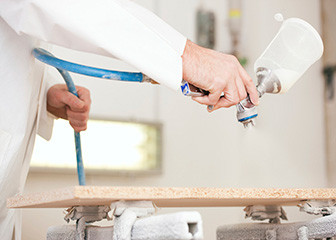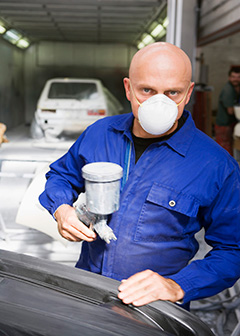What Painting and Coating Workers Do
About this section

Painting and coating workers paint a variety of surfaces, including wood.
Painting and coating workers paint and coat a wide range of products, including cars, jewelry, and candy.
Duties
Painting and coating workers typically do the following:
- Set up and operate machines that paint or coat products
- Select the paint or coating needed for the job
- Clean and prepare products to be painted or coated
- Determine the required flow of paint and the quality of the coating
- Clean and maintain tools and equipment
Millions of items ranging from cars to candy are covered by paint, plastic, varnish, chocolate, or some other type of coating. Painting or coating is used to make a product more attractive or protect it from the elements. The paint finish on an automobile, for example, makes the vehicle more attractive and provides protection from corrosion.
Before workers begin to apply the paint or other coating, they often need to prepare the surface by sanding or cleaning it carefully to prevent dust from becoming trapped under the paint. Sometimes, masking is required, which involves carefully covering portions of the product with tape and paper.
After the product is prepared, workers may use a number of techniques to apply the paint or coating. Perhaps the most straightforward technique is dipping an item in a large vat of paint or some other coating. Spraying products with a solution of paint or another coating is also common. Some factories use automated painting systems.
The following are types of painting and coating workers:
Dippers use power hoists to immerse products in vats of paint, liquid plastic, or other solutions. This technique is commonly used for small parts in electronic equipment, such as cell phones.
Spray machine operators use spray guns to coat metal, wood, ceramic, fabric, paper, and food products with paint and other coating solutions.
Coating, painting, and spraying machine setters, operators, and tenders position the spray guns, set the nozzles, and synchronize the action of the guns with the speed of the conveyor carrying products through the machine and through drying ovens. During the operation of the painting machines, these workers tend the equipment, watch gauges on the control panel, and check products to ensure that they are being painted evenly. The operator may use a manual spray gun to “touch up” flaws.
Painting, coating, and decorating workers paint, coat, or decorate products such as furniture, glass, pottery, toys, cakes, and books. Some workers coat confectionery, bakery, and other food products with melted chocolate, cheese, oils, sugar, or other substances. Paper is often coated to give it its gloss. Silver, tin, and copper solutions are frequently sprayed on glass to make mirrors.
Transportation equipment painters are the best known group of painting and coating workers. There are three major specialties:
Transportation equipment workers who refinish old or damaged cars, trucks, and buses in automotive body repair and paint shops normally apply paint by hand with a controlled spray gun. Those who work in repair shops are among the most highly skilled manual spray operators: They perform intricate, detailed work and mix paints to match the original color, a task that is especially difficult if the color has faded. Preparing an old car is similar to painting other metal objects.
Transportation equipment painters who work on new cars oversee several automated steps. A modern car is first dipped in an anticorrosion bath, coated with colored paint, and then painted in several coats of clear paint to prevent damage to the colored paint.
Other transportation equipment painters either paint equipment too large to paint automatically—such as ships or giant construction equipment—or do touchup work to fix flaws in the paint caused by damage either during assembly or during the automated painting process.






